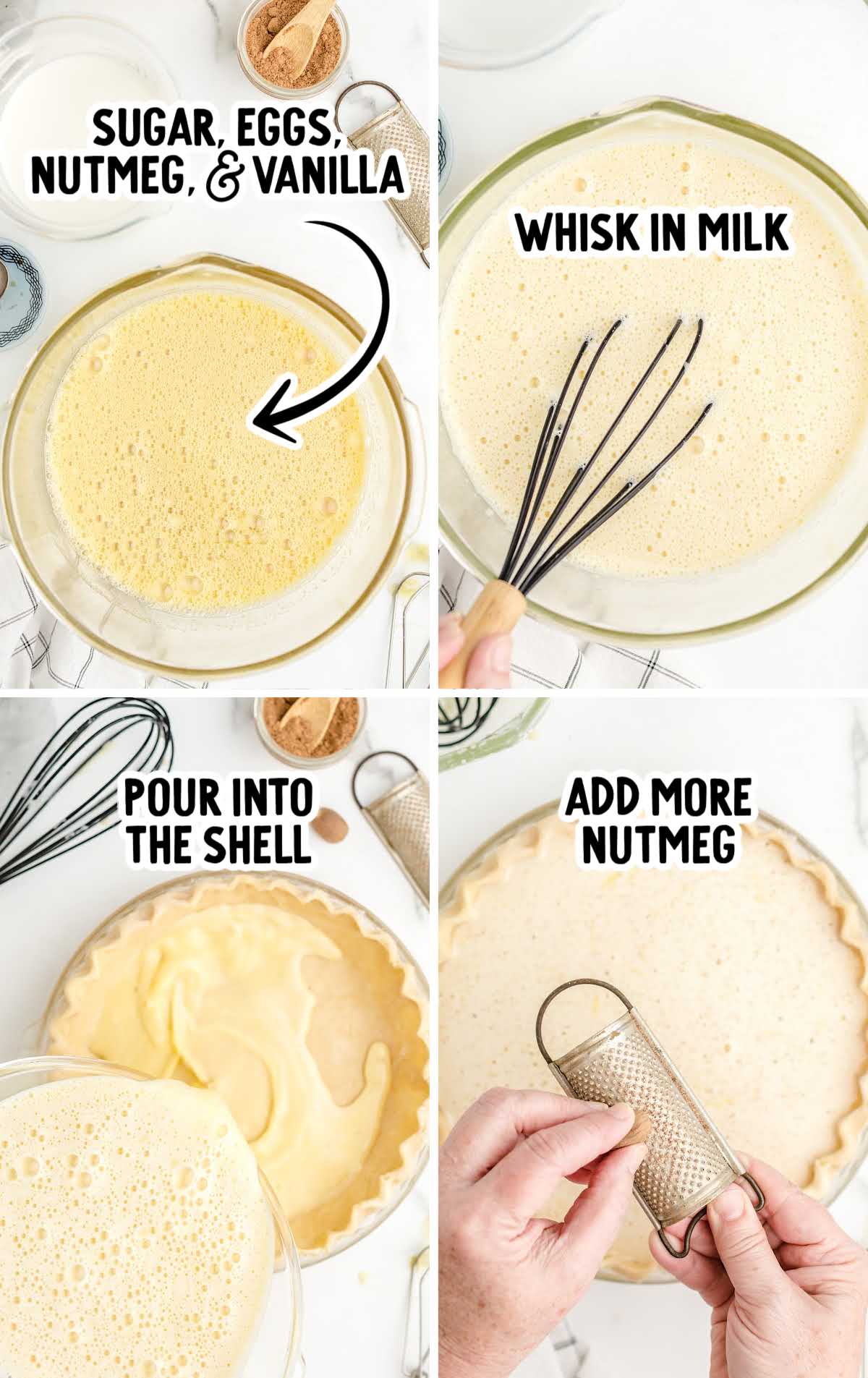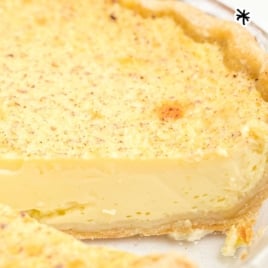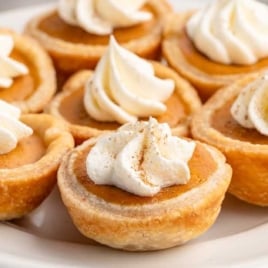
This is the custard pie recipe you actually want. That creamy, old-school Southern texture you remember? This pie nails it — soft-set, silky, and just barely firm enough to slice cleanly once chilled. The top gets that telltale golden top, the center jiggles like it should, and the flavor is all warm vanilla with just a whisper of nutmeg.
And here’s what most recipes skip:
- The trick to getting that texture just right — no curdling, no overbaking, no watery mess.
- Why room-temperature eggs and milk aren’t optional.
- How to bake it so the top doesn’t crack and the crust stays crisp.
You’ll find it all below.
Custard Pie Recipe Ingredients

You’ll need:
- 1 unbaked pie crust
- 1 cup of sugar
- 6 large eggs, having them at room temperature is a must
- ¼ teaspoon of nutmeg
- 2 teaspoons of vanilla
- 3 cups of whole milk, having it at room temperature is a must
- ⅛ teaspoon of nutmeg, for garnish
How To Make Custard Pie

Importance of Room Temperature Ingredients
Ensure your eggs and milk are at room-temperature. Cold milk = sudden temp shift = grainy custard.
Remember, baking is a science that requires precision. Small details, like the temperature of your ingredients, can significantly impact the final result. So, for the perfect custard pie, take the extra time to bring your eggs and milk to room temperature before starting your recipe.
What To Do If Your Custard Mixture Has Lumps
Lumps usually form when eggs start to cook too quickly — often from adding warm milk too fast, using cold ingredients, or not mixing thoroughly.
To fix it, pour the mixture through a fine-mesh sieve set over a bowl. Gently press with a spatula to strain out any solids. If needed, strain a second time. Once smooth, pour into your pie shell and bake as directed.
Is Your Custard Pie Done? How to Perform The Jiggle Test
To perform the jiggle test, open the oven door and gently shake the pie pan by lightly holding one edge. Be careful not to jostle it too much, as this could cause cracks in your custard.
‼️ You’re looking for a slight jiggle in the very center of the pie. The outer edges of the pie should be mostly set and not wobble much, if at all. ‼️
- If the whole pie wobbles or sloshes, it needs more time.
- If there’s no jiggle at all, it may be overbaked — which can result in a texture that’s more like scrambled eggs than creamy custard.

Remember, it’s better to err on the side of slightly undercooking a custard pie. As it cools, the residual heat will continue to cook the custard to the perfect consistency.
Note – Use a glass or ceramic pie pan – metal heats too fast and can overcook the custard.
Serving Suggestions
Add a bit of whipped cream on top of the pie and fresh berries.
Storage Instructions
Chill completely before slicing. Trust me — it cuts better, tastes better, and the texture is peak creamy once cold. Store in the fridge, tightly covered. It’s best within three days.

More Custard Recipes
Our magic custard cake is truly amazing in the way the layers separate while baking.
For another custard recipe, check out our cream puff dessert, which is filled with a yummy custard inside a flaky puff pastry and topped with chocolate and whipped cream.

Easy Custard Pie Recipe
Ingredients
- 1 unbaked pie crust
- 1 cup sugar
- 6 large eggs, room temperature
- 2 teaspoons vanilla
- ¼ teaspoon nutmeg
- 3 cups whole milk, room temperature
- ⅛ teaspoon nutmeg, garnish
Instructions
- Preheat oven to 350°F.
- Lightly spray a 9½-inch pie pan with nonstick spray.
- Place unbaked pie crust in pie pan, pressing dough against the sides of the pie pan.
- Whisk together sugar, eggs, ¼ teaspoon nutmeg, and vanilla for 2 minutes. Add milk and whisk for another 3 minutes until smooth.
- Pour mixture into pie shell.
- Sprinkle the remaining ⅛ teaspoon nutmeg lightly on top of the custard.
- Bake for 1 hour and 15 minutes or until set.
- Slice and serve.
Video
Notes
- Using room-temperature eggs and milk help with even cooking.
- You’ll be able to tell when it’s done by doing a simple jiggle test. Try gently shaking the pie pan, and if the center of the pie jiggles slightly, it’s done!
- This pie tastes and cuts best when chilled.
- The eggs and milk should be at room temperature before baking. You’ll be able to tell when it’s done by doing a simple jiggle test. Try gently shaking the pie pan, and if the center of the pie jiggles slightly, it’s done!














Comments
Layne Henderson says
This is a delicious favorite for us – we love it!
Bunty says
Can you add coffee creamer for half the milk
Layne Henderson says
I have not tried that before, so I am not sure how it would turn out!
Debbie says
Hi. Sounds delicious. Was wondering if you can just make this as a custard but in a pie shell?
Layne Henderson says
It’s super yummy! I’m not sure I understand your question??
carleen says
Does the crust brown on the bottom with so much liquid baking in it? I have never made custard pie and hate soggy or doughy crusts. The pie looks delicious in the photo.
Layne Henderson says
I was iffy at first, but it’s an old family recipe from grandma’s recipe box and it came out perfect!
Teresa Houchins says
You can brush the bottom and sides of the pie crust with beaten egg white to prevent soggy crust
Karen Accomando says
can you put these into 6-8 custard cups just using the filling? maybe cook for 30 mins?
Layne Henderson says
I haven’t made it like that, so I can’t say for sure how it would turn out! You could definitely try! Good luck 🙂
Donna @ Modern on Monticello says
I haven’t had this since childhood that I can remember. Can’t wait to try it. Thanks for sharing your recipe at #HomeMattersParty
Treena says
I can’t wait to try this out! Reminds me of my childhood, my mom would always make custard with jello!
Gloria says
Do you have recipe you use for pie crust?
Layne Henderson says
I don’t have one posted yet, I’ll have to do that! You could use your favorite pie crust recipe or a store-bought pie shell.
Jeanette says
Do you have a recipe using jello
Layne Kangas says
For custard pie? No, we don’t. We have several other recipes that do use Jello for other treats though.
Patri says
Can you put this recipe in an already baked crust ? Like a Graham cracker crust?
Layne Henderson says
I haven’t tried that before – I think it would burn that because you put the crust in unbaked to bake along with the filling. If your crust was graham cracker or already baked, I think it would burn right up.
Grace says
Can cherries or coconut be added? My mom used to purchase cherry and coconut custard pies?
Layne Henderson says
I’m not sure – I haven’t ever tried it that way so I don’t want to say yes and then have it not turn out for you! You could definitely experiment and try 🙂 Enjoy!
Kms says
Yes, you most certainly can add it. I haven’t tried the cherries but I have tried the coconut. I do something different to my pie crust to keep it from being soggy by using a pastry brush to spread egg whites. It works really well.
ann zinser says
What size pan for this pie recipe
Layne Henderson says
You can make two 9-inch pies with this amount of filling, baking for 45 minutes to 1 hour. Or you can use one 10-inch pie pan as pictured with this filling, baking for 90 minutes.